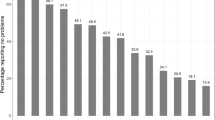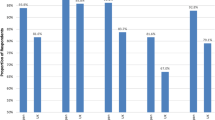Abstract
The Visual Analog Scale (VAS) has become popular in eliciting valuations of health-related quality of life. The aim of the study was to explore the effect of greater exposure to own-health data on the VAS evaluation. A survey of 2,500 individuals included three measurements of the VAS, which differed in time and in the accumulated recall data to which the respondent had been exposed. Agreement among the three measurements was tested in several ways. The results generally showed that the VAS is a stable measure. The intraclass correlation coefficient (ICC) was 0.881. The paired t-tests indicated that the differences between the measurements were insignificant. More than half of the sample reported exactly the same VAS value in the three measurements. The use of the VAS measure, without any other preparation, seems to invoke the own-health data needed to report an accurate evaluation of health-related quality of life at any point in time.
Similar content being viewed by others
References
Torrance, G.W.: Social preferences for health states: an empirical evaluation of three measurement techniques. Socioecon Plann Sci 10, 129–138 (1978)
Bleichrodt, H., Johannesson, M.: An experimental test of a theoretical foundation for rating scale valuations. Med Decis Making 17, 208–216 (1997)
Brooks, R.: with the Euroqol Group, Euroqol: the current state of play. Health Policy 37, 53–72 (1996)
Shmueli, A.: The relationship between VAS and the SF-36 scales in the general population: an update. Med Decis Making 24, 61–63 (2004)
Robinson, A., Loomes, G., Jones-Lee, M.: Visual analog scales, standard gambling and relative risk aversion. Med Decis Making 21, 17–27 (2001)
Torrance, G.W., Feeny, D., Furlong, W.: Visual analog scales: do they have a role in the measurement of preferences for health states? Med Decis Making 21, 329–334 (2001)
Parkin, D., Rice, N., Jacoby, A., Doughty, J.: Use of VAS in a daily patient diary: modeling cross-sectional time-series data on health-related quality of life. Soc Sci Med 59, 351–360 (2004)
Schweikert, B., Hahman, H., Leidl, R.: Validation of the EuroQol questionnaire in cardiac rehabilitation. Heart 92, 62–67 (2006)
Konig, H.H., Ulshofer, A., Gregor, M., von Tirpitz, C., Reinshagen, M., Adler, G., Leidl, R.: Validation of the EuroQol questionnaire in patients with inflammatory bowel disease. Eur J Gastroenterol Hepatol 14, 1205–1211 (2002)
Shmueli, A.: Israelis evaluate their health care system. Health Policy 63, 279–287 (2002)
Moses, B., Heyd, D. The good life—the missing dimension in modern medicine. The Israeli National Institute for Health Policy Research, Tel Hashomer (1999)
Shrout, P.E., Fleiss, J.L.: Intraclass correlations: uses in assessing rater reliability. Psychol Bull 86, 420–427 (1979)
Altman, D.G.: Practical statistics for medical research. Chapman & Hall, London (1991)
Efron, B.: An introduction to the bootstrap. Chapman & Hall, New York (1993)
Acknowledgments
The research was partly funded by a grant from the National Institute for Health Policy Research in Israel. Two anonymous referees provided useful comments on an earlier version of the paper.
Author information
Authors and Affiliations
Corresponding author
Rights and permissions
About this article
Cite this article
Shmueli, A., Messika, D., Murad, H. et al. Does greater exposure to own-health data make a difference on the visual analog scale?. Eur J Health Econ 9, 63–67 (2008). https://doi.org/10.1007/s10198-007-0040-y
Received:
Accepted:
Published:
Issue Date:
DOI: https://doi.org/10.1007/s10198-007-0040-y




